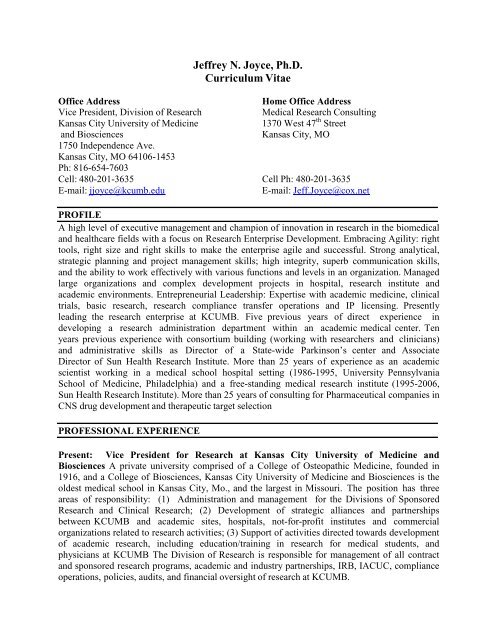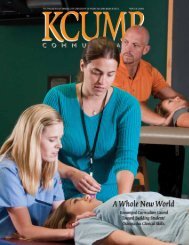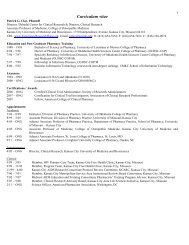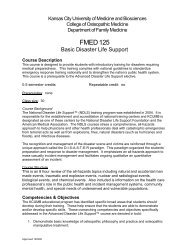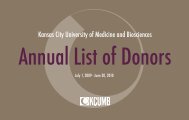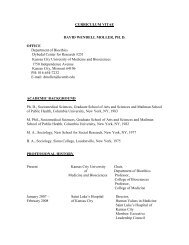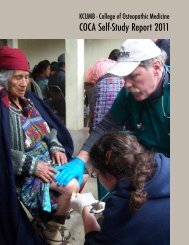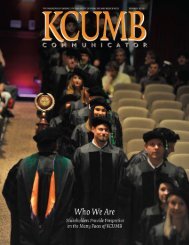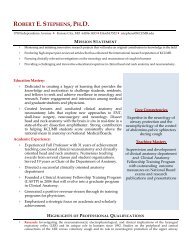Jeffrey Joyce CV 11-8-12 - Kansas City University of Medicine and ...
Jeffrey Joyce CV 11-8-12 - Kansas City University of Medicine and ...
Jeffrey Joyce CV 11-8-12 - Kansas City University of Medicine and ...
You also want an ePaper? Increase the reach of your titles
YUMPU automatically turns print PDFs into web optimized ePapers that Google loves.
Office AddressVice President, Division <strong>of</strong> Research<strong>Kansas</strong> <strong>City</strong> <strong>University</strong> <strong>of</strong> <strong>Medicine</strong><strong>and</strong> Biosciences1750 Independence Ave.<strong>Kansas</strong> <strong>City</strong>, MO 64106-1453Ph: 816-654-7603<strong>Jeffrey</strong> N. <strong>Joyce</strong>, Ph.D.Curriculum VitaeHome Office AddressMedical Research Consulting1370 West 47 th Street<strong>Kansas</strong> <strong>City</strong>, MOCell: 480-201-3635 Cell Ph: 480-201-3635E-mail: jjoyce@kcumb.eduE-mail: Jeff.<strong>Joyce</strong>@cox.netPROFILEA high level <strong>of</strong> executive management <strong>and</strong> champion <strong>of</strong> innovation in research in the biomedical<strong>and</strong> healthcare fields with a focus on Research Enterprise Development. Embracing Agility: righttools, right size <strong>and</strong> right skills to make the enterprise agile <strong>and</strong> successful. Strong analytical,strategic planning <strong>and</strong> project management skills; high integrity, superb communication skills,<strong>and</strong> the ability to work effectively with various functions <strong>and</strong> levels in an organization. Managedlarge organizations <strong>and</strong> complex development projects in hospital, research institute <strong>and</strong>academic environments. Entrepreneurial Leadership: Expertise with academic medicine, clinicaltrials, basic research, research compliance transfer operations <strong>and</strong> IP licensing. Presentlyleading the research enterprise at KCUMB. Five previous years <strong>of</strong> direct experience indeveloping a research administration department within an academic medical center. Tenyears previous experience with consortium building (working with researchers <strong>and</strong> clinicians)<strong>and</strong> administrative skills as Director <strong>of</strong> a State-wide Parkinson’s center <strong>and</strong> AssociateDirector <strong>of</strong> Sun Health Research Institute. More than 25 years <strong>of</strong> experience as an academicscientist working in a medical school hospital setting (1986-1995, <strong>University</strong> PennsylvaniaSchool <strong>of</strong> <strong>Medicine</strong>, Philadelphia) <strong>and</strong> a free-st<strong>and</strong>ing medical research institute (1995-2006,Sun Health Research Institute). More than 25 years <strong>of</strong> consulting for Pharmaceutical companies inCNS drug development <strong>and</strong> therapeutic target selectionPROFESSIONAL EXPERIENCEPresent: Vice President for Research at <strong>Kansas</strong> <strong>City</strong> <strong>University</strong> <strong>of</strong> <strong>Medicine</strong> <strong>and</strong>Biosciences A private university comprised <strong>of</strong> a College <strong>of</strong> Osteopathic <strong>Medicine</strong>, founded in1916, <strong>and</strong> a College <strong>of</strong> Biosciences, <strong>Kansas</strong> <strong>City</strong> <strong>University</strong> <strong>of</strong> <strong>Medicine</strong> <strong>and</strong> Biosciences is theoldest medical school in <strong>Kansas</strong> <strong>City</strong>, Mo., <strong>and</strong> the largest in Missouri. The position has threeareas <strong>of</strong> responsibility: (1) Administration <strong>and</strong> management for the Divisions <strong>of</strong> SponsoredResearch <strong>and</strong> Clinical Research; (2) Development <strong>of</strong> strategic alliances <strong>and</strong> partnershipsbetween KCUMB <strong>and</strong> academic sites, hospitals, not-for-pr<strong>of</strong>it institutes <strong>and</strong> commercialorganizations related to research activities; (3) Support <strong>of</strong> activities directed towards development<strong>of</strong> academic research, including education/training in research for medical students, <strong>and</strong>physicians at KCUMB The Division <strong>of</strong> Research is responsible for management <strong>of</strong> all contract<strong>and</strong> sponsored research programs, academic <strong>and</strong> industry partnerships, IRB, IACUC, complianceoperations, policies, audits, <strong>and</strong> financial oversight <strong>of</strong> research at KCUMB.
<strong>Jeffrey</strong> N. <strong>Joyce</strong>, Ph.D. December 20<strong>12</strong>• Oversees the development <strong>of</strong> current <strong>and</strong> long-term organizational goals <strong>and</strong> objectives aswell as policies <strong>and</strong> procedures for KCUMB research operations• Coordinate with local universities, hospitals, <strong>and</strong> institutions to establish cooperativeagreements to enhance research programs <strong>and</strong> increase external funding <strong>of</strong> research• In conjunction with CFO manage financial aspects <strong>of</strong> research activities, includingbudgets, cash flow projections <strong>and</strong> financial reports• Develop <strong>and</strong> implement institutional policies <strong>and</strong> practices to ensure that MIHS meets allregulatory requirements <strong>and</strong> assurances for the conduct <strong>of</strong> sponsored programs (research,grants <strong>and</strong> contracts) including requirements for managing financial conflicts <strong>of</strong> interest,investigating scientific misconduct <strong>and</strong> reviewing human subjects research.• Oversee development <strong>of</strong> research facilities <strong>and</strong> common equipment, including planning forresearch infrastructure project development2007 - 20<strong>12</strong> Director <strong>of</strong> the Department <strong>of</strong> Research, Maricopa Integrated Health SystemMaricopa Integrated Health Service (MIHS) includes the Maricopa Hospital <strong>and</strong> Medical Center<strong>and</strong> eleven Family Health Centers located throughout the Phoenix metropolitan area. As anacademic medical center it is home to 10 residency programs that provide training forapproximately 60% <strong>of</strong> all physicians in the State <strong>of</strong> Arizona. The department was developedunder my leadership from 2007 to 20<strong>12</strong>.Milestones• 2007 Developed two divisions to improve oversight <strong>of</strong> research activities:-Pharmaceutical Contracts <strong>and</strong> Compliance, <strong>and</strong>-Academic Research <strong>and</strong> IRB AdministrationThis ensured proper management <strong>of</strong> all contract <strong>and</strong> sponsored research programs, academicresearch, human subject protection, research policies, audits, <strong>and</strong> financial oversight <strong>of</strong>research accounts.• 2008 Worked with Finance Department to put Research Grants Accounting operationsinto place. Research requires separate accounting for each research project <strong>and</strong> a separategrant accounting system is required to effectively manage <strong>and</strong> track these cost centers• Worked with Finance Department to develop operational system to “clean” patientaccounts <strong>of</strong> non-permissible research charges. Aligned with electronic medical recordimplementation.• June 2009 – New indirect cost proposal submitted to DHHS. Substantial increase in costrecovery approved for July 2010. The proposal was developed in cooperation with theDirector <strong>of</strong> Government Reporting for this institution <strong>and</strong> Huron Consulting.• 2009- 2010 Memor<strong>and</strong>um <strong>of</strong> Underst<strong>and</strong>ing for Research <strong>and</strong> Graduate EducationPartnership between Maricopa Integrated Health System <strong>and</strong> Arizona State <strong>University</strong>(ASU, Tempe, AZ) executed. Overarching Technology Transfer agreement betweenMIHS <strong>and</strong> ASU [Arizona Technology Enterprises] approved to implement for allresearch collaborations <strong>and</strong> contracts. Human Subject’s Protection (IRB) reciprocityagreement between MIHS <strong>and</strong> ASU executed. Determines IRB authority over jointresearch programs where clinical research is conducted solely at ASU or MIHS.• Spring 20<strong>11</strong> – Led MIHS’s participation in Arizona Biospecimen Consortium <strong>and</strong>Arizona Public Cord Blood Banking Program funded by Arizona Biomedical ResearchCommission2
<strong>Jeffrey</strong> N. <strong>Joyce</strong>, Ph.D. December 20<strong>12</strong>Accomplishments• Number <strong>of</strong> active research projects (sponsored <strong>and</strong> resident-related) by 160% in 4 years• Number <strong>of</strong> initiated Sponsored contracts completed per month increased by 250%• Number <strong>of</strong> Research projects as part <strong>of</strong> residency training programs increased 375%• Federal grants increased by more than 200% in four years1995- 2006 Concurrent Positions at Sun Health Research Institute, Sun <strong>City</strong> AZ1995- 2006 Associate Director, Sun Health Research InstituteEstablished in 1987, it is a not-for-pr<strong>of</strong>it Institute within the Sun Health Corporationhealthcare network (merged with Banner Health in 2008). The Institute is focused ontransitional research in the neurodegenerative disorders <strong>of</strong> the aged, with emphasis inAlzheimer’s Disease, Parkinson’s Disease <strong>and</strong> Arthritis. Co-managed research <strong>and</strong>development for the Institute, facilitated development <strong>of</strong> grants <strong>and</strong> contracts, leddevelopment <strong>of</strong> strategic alliances with pharmaceutical companies. Personally increasedsponsorship from Pharmaceutical <strong>and</strong> Biotech companies 20-fold from 1995-2000. Directlyinvolved in recruitment <strong>of</strong> faculty that increased from 3 to 36 during the same 10 years, <strong>and</strong>stood at 36 Ph.D.s/M.D.s <strong>and</strong> 36 support staff.1995- 2006 Senior Scientist <strong>and</strong> Head, Thomas H. Christopher Parkinson's DiseaseResearch CenterInstituted the Center in 1995 with one laboratory, <strong>and</strong> exp<strong>and</strong>ed it to encompass fourlaboratories. Responsible for personnel recruitment, program development, fiscalmanagement, fund procurement. The Center was awarded <strong>11</strong> research grants <strong>and</strong> contractsduring that period, including four from pharmaceutical companies, three from the Michael J.Fox Foundation for Parkinson’s Disease Research, <strong>and</strong> three NIH-funded awards.1997- 2004 Head, Arizona Parkinson’s Disease CenterResponsible for strategic development <strong>of</strong> the consortium in 1997 that <strong>of</strong>ficially became theArizona Parkinson’s Disease Center in the year 2000. Led the strategic development <strong>and</strong>political action committee in 2000 that developed State <strong>of</strong> Arizona Legislature funding forParkinson’s Disease. Administrative Director from 2000-2004 for 3 clinical sites <strong>and</strong> 6research laboratories (at two institutes) that constituted the Arizona Parkinson’s DiseaseCenter. Oversaw all aspects <strong>of</strong> administration: budget, support staff, regulations (IRB), <strong>and</strong>fund procurement.1995- 2005 Co-Director Parkinson’s Disease Brain Donor Program.In 1995, in collaboration with Dr. Charles Adler (Mayo Clinic- Scottsdale), initiated thedevelopment <strong>of</strong> an antemortem clinical testing program for the Sun Health ResearchInstitute Brain Donor Program. The program exp<strong>and</strong>ed to support neuropathologicalassessment, enrollment <strong>of</strong> Parkinson’s Disease subjected <strong>and</strong> ultimately a clinical researchprogram with Parkinson’s cases. Dr. <strong>Joyce</strong> developed internal <strong>and</strong> external funding for theprogram from 1998-2004. The Arizona Parkinson’s Disease Center is now headed by Dr.Adler, with Dr. Thomas Beach as head <strong>of</strong> the pathology services component.3
<strong>Jeffrey</strong> N. <strong>Joyce</strong>, Ph.D. December 20<strong>12</strong>1995- present Pharmaceutical Consultant, CNS Drug Discovery <strong>and</strong> Target DevelopmentConsultant to UpJohn Pharmacia <strong>and</strong> Pharmacia Corporation for 6 years in anti-Parkinsonian drug development before company was acquired by Pfizer. Consultant toInstitute de Recherchés Servier (Suresnes, France) for five years for antipsychotic <strong>and</strong>anti-Parkinsonian drug development. Consultant to Pfizer Pharmaceuticals, Eli Lilly <strong>and</strong>Company, Schwarz Biosciences, Forest Laboratories, Gedeon Richter Plc.1986-1995 Positions at <strong>University</strong> <strong>of</strong> Pennsylvania School <strong>of</strong> <strong>Medicine</strong>, PhiladelphiaPA1989-1995 Associate Pr<strong>of</strong>essor <strong>of</strong> Psychology <strong>and</strong> Neuroscience in Psychiatry <strong>and</strong>Director <strong>of</strong> the Laboratory <strong>of</strong> Molecular Neurochemistry, <strong>University</strong> <strong>of</strong>Pennsylvania School <strong>of</strong> <strong>Medicine</strong>, Philadelphia PAFaculty Member: School <strong>of</strong> <strong>Medicine</strong> in the Department <strong>of</strong> Psychiatry, CRBPsychiatry Research, directed research programs in developmental neurobiology <strong>and</strong> themolecular neurochemistry <strong>of</strong> the human brain, particularly related to neuropsychiatric <strong>and</strong>neurodegenerative illnesses.Responsibilities included research laboratory operations including fiscal management,supervision <strong>of</strong> 18 scientists, <strong>and</strong> fund procurement. P.I. in several program project grantsthat crossed departmental boundaries in Pharmacology, Neurosurgery <strong>and</strong>Neuropathology. Awarded <strong>11</strong> grants including 2 NIH R01 grants.Research Excellence: Awarded the prestigious Ziskind-Somerfeld Research Award forresearch into the biological substrates <strong>of</strong> schizophrenia by the Society for BiologicalPsychiatry in 1997.1989-1990, Director, Clinical Research Building Psychiatry Research DepartmentFacilitated the consolidation <strong>of</strong> 9 laboratories spread through the <strong>University</strong> Campus to oneResearch Building, inaugurating the comprehensive basic research programs <strong>of</strong> the ResearchDepartment in Psychiatry1986-1989 Research Assistant Pr<strong>of</strong>essor <strong>of</strong> Pharmacology, <strong>University</strong> <strong>of</strong> PennsylvaniaSchool <strong>of</strong> <strong>Medicine</strong>, Philadelphia PAFaculty member <strong>of</strong> the School <strong>of</strong> <strong>Medicine</strong> in the Department <strong>of</strong> Pharmacology,Associate Member David Mahoney Institute <strong>of</strong> Neurological Sciences, MemberGraduate Group in Pharmacology, <strong>University</strong> <strong>of</strong> Pennsylvania.Responsibilities included teaching graduate courses, laboratory operations includingfiscal management, supervision <strong>of</strong> 8 staff, <strong>and</strong> fund procurement. Awarded 5independent grants in three-year period.ADDITIONALEXPERIENCEPROFESSIONAL2010- 20<strong>12</strong> Executive Steering Committee for the CONECTR (Community Oriented4
<strong>Jeffrey</strong> N. <strong>Joyce</strong>, Ph.D. December 20<strong>12</strong>Network to Enhance Clinical Trials <strong>and</strong> Research) an ASU-Quintiles alliance.2009 - 20<strong>12</strong> Board Member <strong>of</strong> Carl T. Hayden Medical Research Foundation (Phoenix, AZ),associated with the Phoenix VA Health Care System2006 -2009 Liason Committee member, American College <strong>of</strong> Neuropsychopharmacology2001 - 2004 Finance Committee member, American College <strong>of</strong> Neuropsychopharmacology1995- 2006 Radiation Safety Officer, Sun Health Research Institute2001 - 2006 Flinn Foundation –Battelle Commission Bioindustry Roadmap-NeurosciencePlatform Committee1997 - 2000 Board Member <strong>and</strong> Finance Committee Chair, Annual Spring BrainConference1994 - 1994 Chair Finance Committee International Behavioral Neuroscience Society1993 - 1993 Program Chair, International Behavioral NeuroscienceMEMBERSHIP IN PROFESSIONAL AND SCIENTIFIC SOCIETIESNational Organization <strong>of</strong> Research Development Pr<strong>of</strong>essionals (2010)Health Care Compliance Association (2010)Society <strong>of</strong> Research Administrators (SRA) International (2009)American College <strong>of</strong> Healthcare Executives (2008)Public Responsibility in <strong>Medicine</strong> <strong>and</strong> Research (2008)Society for Neuroscience (1978)Society for Biological Psychiatry (1989)International Society for Developmental Neuroscience (1989)American Society for Pharmacology <strong>and</strong> Experimental Therapeutics (1990)American College <strong>of</strong> Neuropsychopharmacology-Associate Member (1992-1994)-Member (1995)-Fellow (2002)- Liaison Committee member (2005-2009)- Finance Committee member (2001-2004)International Behavioral Neuroscience Society (Charter Member, 1992)-Program Chair (1993)-Chair Finance Committee (1994-1995) -Doubled annual sponsorship support-Fellow (1995)Annual Spring Brain Conference (1995)-Board Member (1997-2000)-Finance Committee Chair (1997-2000) -Quadrupled annual sponsorship supportThe Movement Disorders Society (1996)Collegium Internationale Neuro-Psychopharmacolgicum (2000)European College <strong>of</strong> Neuropsychopharmacology (2004)5
<strong>Jeffrey</strong> N. <strong>Joyce</strong>, Ph.D. December 20<strong>12</strong>Editorial Board Synapse (1992- 2004)Neuropsychopharmacology (1995- 2000)Neurotoxicity Research (1998-2007)Grant Reviews- Clinical Neuroplasticity <strong>and</strong> Neurotransmitters [CNNT] study section (2006-2007)- Neurodegeneration <strong>and</strong> the Biology <strong>of</strong> the Glia Study Section [NDBG] (2005-2007)- NIA ZAG1 ZIJ-9 (M3) Beeson Career Development- Special Emphasis Panel (2005-2007)- VA Merit Review Subcommittee – Chair, Neurobiology D. (2003-2007)-Department <strong>of</strong> Defense-Neurotoxin Exposure Program review panel (2002)-Reviewer for American Federation for Aging Research (1999-2003)-Reviewer for Veterans Administration Merit Award (external)-Reviewer for American Health Assistance Foundation (external)-Reviewer for Natural Sciences <strong>and</strong> Engineering Research Council <strong>of</strong> Canada (external)-Reviewer for The Wellcome Trust, London, Engl<strong>and</strong> (external)-Reviewer for Ontario Mental Health Foundation, Canada (external)-Reviewer for NSF grants (external)-Reviewer for NIMH – Ad Hoc to Review Group NPNC (1995-1998)ACADEMIC EXPERIENCE (1986-20<strong>11</strong>)EDUCATION1983-1986 <strong>University</strong> <strong>of</strong> California, Irvine, Department <strong>of</strong> Psychobiology, NRSA <strong>and</strong>NINDS Postdoctoral Fellowships1977-1983 <strong>University</strong> <strong>of</strong> Florida, Gainesville, Departments <strong>of</strong> Psychology <strong>and</strong> <strong>of</strong>Neuroscience. Ph.D. awarded 1986 in Physiological Psychology1974-1977 <strong>University</strong> <strong>of</strong> Illinois, Champaign-Urbana, IL. B.S. in Psychology/BiologyCognatePostgraduate Training <strong>and</strong> Fellowship Appointments1983-85 NRSA Postdoctoral Training Grant, Postdoctoral Trainee, Department <strong>of</strong>Psychobiology, <strong>University</strong> <strong>of</strong> California at Irvine1985-86 NINCDS Postdoctoral Fellowship, Department <strong>of</strong> Psychobiology, <strong>University</strong> <strong>of</strong>California at IrvineFACULTY APPOINTMENTS20<strong>12</strong> - Pr<strong>of</strong>essor <strong>of</strong> Pharmacology, <strong>Kansas</strong> <strong>City</strong> <strong>University</strong> <strong>of</strong> <strong>Medicine</strong> <strong>and</strong> Biosciences20<strong>11</strong>- 20<strong>12</strong> Research Pr<strong>of</strong>essor <strong>of</strong> Neurology <strong>and</strong> Psychiatry <strong>University</strong> <strong>of</strong> Arizona College<strong>of</strong> <strong>Medicine</strong> - Phoenix2007 – 20<strong>12</strong> Adjunct Pr<strong>of</strong>essor in the School <strong>of</strong> Biological <strong>and</strong> Health Systems Engineering,Arizona State <strong>University</strong>, Tempe, AZ1995- 2006 Senior Scientist <strong>and</strong> Head, Thomas H. Christopher Parkinson's Disease Research6
<strong>Jeffrey</strong> N. <strong>Joyce</strong>, Ph.D. December 20<strong>12</strong>Center1998- 2007 Adjunct Pr<strong>of</strong>essor in the Molecular <strong>and</strong> Cellular Biology Graduate Group,Arizona State <strong>University</strong>, Tempe, AZ1996- 2007 Adjunct Pr<strong>of</strong>essor <strong>of</strong> Psychology, Arizona State <strong>University</strong>, Tempe, AZ1995-1998 Adjunct Associate Pr<strong>of</strong>essor <strong>of</strong> Psychology <strong>and</strong> Neuroscience in Psychiatry,<strong>University</strong> <strong>of</strong> Pennsylvania School <strong>of</strong> <strong>Medicine</strong>, Philadelphia, PA1992-1995 Member, Graduate Group in Neuroscience, <strong>University</strong> <strong>of</strong> Pennsylvania1989-1995 Research Associate Pr<strong>of</strong>essor <strong>of</strong> Psychology <strong>and</strong> Neuroscience in Psychiatry1989-1995 Research Associate Pr<strong>of</strong>essor <strong>of</strong> Pharmacology (Secondary with voting rights)1987-1995 Associate Member David Mahoney Institute <strong>of</strong> Neurological Sciences1987-1989 Research Assistant Pr<strong>of</strong>essor <strong>of</strong> Pharmacology in Psychiatry (Secondary)1986-1995 Member Graduate Group in Pharmacology, <strong>University</strong> <strong>of</strong> Pennsylvania1986-1989 Research Assistant Pr<strong>of</strong>essor <strong>of</strong> Pharmacology, <strong>University</strong> <strong>of</strong> PennsylvaniaACADEMIC COMMITTEES (1986-2006)Academic Committees at the <strong>University</strong> <strong>of</strong> Pennsylvania (1986-1994)1986-1994 Member, Faculty Advisory Board on Aging1988-1994 Member, Executive Board, Hartford Foundation Aging Fellowship Program1989-1994 Member, Research Committee in Psychiatry1988-19941991-1992Member, Institute <strong>of</strong> Neurological Sciences Admission's CommitteeMember, Committee to Review the Department <strong>of</strong> Microbiology Chair,1992-1994 Graduate Education in Psychiatry SubcommitteeMaior Teaching <strong>and</strong> Clinical Responsibilities at the Univeristy <strong>of</strong> Pennsylvania (1986 - 1995):1. Director, Laboratory <strong>of</strong> Chemical Neuroanatomy2. Course Director, Pharamcology-Psychiatry 550: Neuropsyhopharmacology3. Course Director, Pharmacology 100: Behavioral Pharmacology Laboratory4. Co-Director, Pharmacology 540: Behavioral Neuropharmacology5. Lecturer, Pharmacology 510: Neurochemistry6. Lecturer to Biological Basis <strong>of</strong> Psychiatric Disorders, BBB-Psychiatry 280Academic Committees at Arizona State <strong>University</strong> (1997- 2006)Thesis Advisory Committee: Taline Khroyan, Department <strong>of</strong> PsychologyThesis Advisory Committee: Rita Fuchs, Department <strong>of</strong> PsychologyCo-Chair Thesis Advisory Committee: Steve Presgraves, Molecular <strong>and</strong> Cellular BiologyProgram.Member, “Stress Center” Advisory Committee (1999 – 2003)TRAINING AND MENTORING (1986-2006)Postdoctoral Trainees:Bethany Neal-Belliveau, Ph.D., 1987 <strong>University</strong> <strong>of</strong> Minnesota1987- 1991 Postdoctoral Trainee (J.N. <strong>Joyce</strong>, Faculty Supervisor)Support:Training Program in Neuropsycho-pharmacology, Department <strong>of</strong> Pharmacology,7
<strong>Jeffrey</strong> N. <strong>Joyce</strong>, Ph.D. December 20<strong>12</strong><strong>University</strong> <strong>of</strong> Pennsylvania School <strong>of</strong> <strong>Medicine</strong>Tourette Syndrome Association (7/1/90 - 6/30/91), Developmental Plasticity <strong>of</strong> BasalGanglia Dopamine Systems,Total Direct Costs: $25,000National Institute <strong>of</strong> Mental Health (10/1/90 - 9/30/91), Dopamine Denervation <strong>and</strong>Receptor Subtype Regulation (F32 MH09888), Total Direct Costs: $28,000Current Postion: Associate Pr<strong>of</strong>essor <strong>of</strong> Psychology, Indiana <strong>University</strong>, Indianapolis, INAngela Murray, Ph.D., 1990 Royal College <strong>of</strong> Surgeons, Dublin, Irel<strong>and</strong>1990-1992 Postdoctoral Fellow (J.N. <strong>Joyce</strong>, Faculty Supervisor)Support:National Parkinson Foundation, Inc. (7/01/91 - 6/30/92), Dopamine Receptors inParkinson's <strong>and</strong> Alzheimer's Disease, Total Direct Costs: $40,000.Current Postion: Intellecutal Patents Advisor, Dublin, Irel<strong>and</strong>Lise Rioux, Ph.D., 1991 Laval Univeristy, Quebec, Canada1991- 1994 Postdoctoral Fellow (J.N. <strong>Joyce</strong>, Faculty Supervisor)Support:Fonds De La Recherche En Sante Du Quebec (7/01/91 - 3/30/94), Temporal Correlation<strong>of</strong> mRNA Coding for dopamine Receptors in Different Striatal Compartments as Relatedto Maturation <strong>of</strong> Dopamine Afferents, Total Direct Costs: $53,000NIB. (4/01/94 - 3/30/95), Substance P Receptors in Parkinson's <strong>and</strong> Alzheimer's Disease,Total Direct Costs: $30,000.Current Postion: Investigator, Dept Neurobiol & Anat, Drexel <strong>University</strong> Medical Center,Philadelphia, PAAdvanced Trainees:Eugenia Gurevich,Ph.D., 1985 Moscow State <strong>University</strong>, Russia1991-1995 Postdoctoral Fellow (J.N. <strong>Joyce</strong>, Faculty Supervisor)1995-2001 Scientist, Thomas H. Christopher Center for Parkinson's Disease ResearchCurrent Postion: Associate Pr<strong>of</strong>essor, Department <strong>of</strong> Pharmacology, V<strong>and</strong>erbilt<strong>University</strong> Medical Center, Nashville, TNInna Kruman, Ph.D., 1983 Moscow State <strong>University</strong>, Russia2001-2006 Staff Scientist, Thomas H. Christopher Center for Parkinson's DiseaseResearchCurent Position: Associate Pr<strong>of</strong>essor, Department <strong>of</strong> Neuropsychiatry, Garrison Instituteon Aging, Texas Tech <strong>University</strong> Health Sciences CenterThesis Supervision:8
<strong>Jeffrey</strong> N. <strong>Joyce</strong>, Ph.D. December 20<strong>12</strong>Sara Goldsmith: "Limbic dopamine D2 receptors: Interspecies differences <strong>and</strong> alterations inschizophrenia," presented in fulfillment <strong>of</strong> Doctor <strong>of</strong> Philosophy degree, Department <strong>of</strong>Psychology, <strong>University</strong> <strong>of</strong> Illinois, Chicago, May 1993. (J.N. <strong>Joyce</strong>, Faculty Supervisor- U Penn)Paul Frohna: "The developmental plasticity <strong>of</strong> the dopamine systems: Effects <strong>of</strong> neonatal 6-hydroxydopamine lesions on the ontogenesis <strong>of</strong> the mesostriatal dopamine neurons <strong>and</strong> <strong>of</strong>striatal dopamine D1 <strong>and</strong> D2 receptors <strong>and</strong> mRNA," Department <strong>of</strong> Pharmacology, <strong>University</strong> <strong>of</strong>Pennsylvania School <strong>of</strong> <strong>Medicine</strong> (awarded, 1995).Steve Presgraves: “SHSY-5Y neuroblastoma cells a DA-phenotypic model system for studyingD3 receptor agonist neuroprotection against MPP+-induced cell death” Center for Molecular <strong>and</strong>Cellular Biology, Arizona State <strong>University</strong>, Tempe AZ (awarded, 2005).T.C. Der, M.S.: “Role <strong>of</strong> the serotonin system in modulating neurotoxicity <strong>of</strong> MPTP todopamine neurons”. Graduate Program in Biology, Arizona State <strong>University</strong>, Tempe AZ(Awarded, 2007).MEDICAL SCIENCE COMMUNICATIONS AND PRESENTRATIONSIn 2007 I moved into the positions with largely administrative responsibilities but remain activein the research community. I have provided over 65 invited lectures at national <strong>and</strong> internationalmeetings, universities <strong>and</strong> other public forums in the areas <strong>of</strong> neuroscience, neuropsychiatry <strong>and</strong>neurodegenerative disorders. I have published over <strong>11</strong>0 original papers, reviews <strong>and</strong> bookchapters on subjects related to the areas <strong>of</strong> neuroscience, neuropsychiatry <strong>and</strong>neurodegenerative disorders.PEER-REVIEWED PUBLICATIONS, INVITED REVIEWS, BOOK CHAPTERSBIBLIOGRAPHYIn Research Administration <strong>and</strong> Development<strong>Joyce</strong>, <strong>Jeffrey</strong> N. Regulatory compliance for research in an academic medical center.Compliance Today [Health Care Compliance Association monthly] Vol 13, No. <strong>12</strong>,Pages 29- 37, December 20<strong>11</strong>.Original Papers1. Wills J, Jones J, Haggerty T, Duka V, <strong>Joyce</strong> JN, Sidhu A. Elevated tauopathy <strong>and</strong> alphasynuclein pathology in postmortem Parkinson's disease brains with <strong>and</strong> withoutdementia.. Exp Neurol. 2010 Sep;225(1):210-82. Massa, S., Yang, T., Xie, Y., Shi, J. Bilgen, M. <strong>Joyce</strong>, J. Nehama, D. Rajadas, J., <strong>and</strong>Longo, F. Small Molecule BDNF Mimetics that Activate TrkB Signaling <strong>and</strong> PreventNeuronal Degeneration. J Clin Invest. 2010 May 3;<strong>12</strong>0(5):1774-85.3. Iarkov, A., Der, T.C., <strong>Joyce</strong>, J.N. Age-related differences in MK-801 induced behaviorsin D 3 receptor knock out mice. European Journal <strong>of</strong> Pharmacology, Volume 627, Issues1-3, 10 February 2010, Pages 177-184.4. Yarkov, A., Der, T.C., <strong>Joyce</strong>, J.N. Locomotor activity induced by MK-801 is enhanced in9
<strong>Jeffrey</strong> N. <strong>Joyce</strong>, Ph.D. December 20<strong>12</strong>dopamine D 3 receptor knock out mice but suppression by dopamine D 3 /D 2 antagonistsdoes not occur through the dopamine D 3 receptor. In Press, European Journal <strong>of</strong>Pharmacology, Volume 627, Issues 1-3, 10 February 2010, Pages 167-172 .5. Duka, T., Duka,V. <strong>Joyce</strong>, J.N. <strong>and</strong> Sidhu, A. Alpha-synuclein induces GSK-3β–catalyzed tau phosphorylation in Parkinson’s Disease models. FASEB J. 2009Sep;23(9):2820-2830.6. Kufah1, P.R. Zavala, A.R., Singh, A., Thiel, K.J., Dickey, E.D., <strong>Joyce</strong>, J.N.,Neisew<strong>and</strong>er, J.L c-Fos expression associated with reinstatement <strong>of</strong> cocaine-seekingbehavior by response-contingent conditioned cues. Synapse. 2009 Oct;63(10):823-835.7. Zavala, A.R., Osredkar, T., <strong>Joyce</strong>, J.N. <strong>and</strong> Neisew<strong>and</strong>er, J.L. Upregulation <strong>of</strong> ArcmRNA expression in the prefrontal cortex following cue-induced reinstatement <strong>of</strong>extinguished cocaine-seeking behavior. Synapse, 2008 Jun;62(6):421-31.8. Mastroeni D, Grover A, Leonard B, <strong>Joyce</strong> JN, Coleman PD, Kozik B, Bellinger DL,Rogers J. Microglial responses to dopamine in a cell culture model <strong>of</strong> Parkinson'sdisease. Neurobiol Aging. 2009 Nov;30(<strong>11</strong>):1805-179. Lockhart, A., Lamb, J.R., Osredkar, T., Sue, L.I., <strong>Joyce</strong>, J.N., Ye, L., Libri, V., Leppert,D. <strong>and</strong> Beach, T.G. PIB is a non-specific imaging marker <strong>of</strong> amyloid-beta (Abeta)peptide-related cerebral amyloidosis. Brain. 2007 Oct;130(Pt 10):2607-26<strong>11</strong>10. Bychkov ER, Gurevich VV, <strong>Joyce</strong> JN, Benovic JL, Gurevich EV. Elevated expression <strong>of</strong>arrestins <strong>and</strong> G protein-coupled receptor kinases in the striatum <strong>of</strong> Parkinson’s patientswith concomitant dementia. Neurobiol Aging. 2008 Mar;29(3):379-96.<strong>11</strong>. Yoshimoto K, Nishimura A, Hattori H, <strong>Joyce</strong> JN, Yoshida T, Hioki C, Kogure A, UedaS. In vivo brain microdialysis studies on the striatal dopamine <strong>and</strong> serotonin release inzitter mutant rats. Mech Ageing Dev. 2006 Jul;<strong>12</strong>7(7):628-32<strong>12</strong>. Nakadate K, Noda T, Sakakibara SI, Kumamoto K, Matsuura T, <strong>Joyce</strong> JN, Ueda S.Progressive dopaminergic neurodegeneration <strong>of</strong> substantia nigra in the zitter mutant rat.Acta Neuropathol (Berl). 2006 Jul;<strong>11</strong>2(1):64-7313. Ueda S, Sakakibara S, Nakadate K, Noda T, Shinoda M, <strong>Joyce</strong> JN. Degeneration <strong>of</strong>dopaminergic neurons in the substantia nigra <strong>of</strong> zitter mutant rat <strong>and</strong> protection bychronic intake <strong>of</strong> Vitamin E. Neurosci Lett. 2005 Jun 3;380(3):252-614. <strong>Joyce</strong>, J.N., Woolsey, C., Ryoo, H., Borwege, S., Hagner, D. A low dose <strong>of</strong> pramipexoleis neuroprotective in the MPTP mouse model <strong>of</strong> Parkinson’s disease, <strong>and</strong> acts todownregulate the dopamine transporter via the D 3 receptor. BMC Biology 2004, 2:22.15. Presgraves, S., Borwege, S., Millan, M. J. <strong>and</strong> <strong>Joyce</strong>, J.N. Neuroprotective effects <strong>of</strong>S32504 <strong>and</strong> pramipexole against 1-methyl-4-phenylpyridinium (MPP+) in terminallydifferentiated SH-SY5Y cells are mediated by the D 3 receptor <strong>and</strong> BDNF dependentpathways. Experimental Neurology, 190(1):157-170.16. Dluzen, D.E., McDermott, J.L., Anderson, L.I., Kucera, J., <strong>Joyce</strong>, J.N., Osredkar, T.,Walro, J.M. Age-related changes in nigrostriatal dopaminergic function are accentuated10
<strong>Jeffrey</strong> N. <strong>Joyce</strong>, Ph.D. December 20<strong>12</strong>in +/- brain derived neurotrophic factor mice. Neuroscience, <strong>12</strong>8:201-208, 2004.17. Presgraves, S., Ahmed, T., Borwege, S. <strong>and</strong> <strong>Joyce</strong>, J.N. Terminally differentiated SH-SY5Y cells provide a model system for studying neuroprotective effects <strong>of</strong> dopamineagonists. Neurotoxicity Research, 5(8):579-598, 2004.18. Neisew<strong>and</strong>er, J.L., Fuchs, R.A., Tran-Nguyen, L.T.L., Weber, S.M., C<strong>of</strong>fey, G.P. <strong>and</strong><strong>Joyce</strong>, J.N. Abstinence from a cocaine self-administration regimen in rats increasesdopamine D 3 receptor binding: Implications for underst<strong>and</strong>ing cocaine-seeking behavior.Neuropsychopharmacology, 29(8):1479-87., 2004.19. Millan, M.J., Di Cara, B., Hill, M., Jackson, M., <strong>Joyce</strong>, J.N., Brotchie, J., McGuire, S.,Crossman, A., Jenner, P., Gobert, A., Peglion, J.-L. <strong>and</strong> Brocco, M. S3504, a novelnaphtoxazine agonist at D3/D2 receptors: II. Actions in rodent, primate <strong>and</strong> cellularmodels <strong>of</strong> antiparkinsonian activity in comparison to ropinirole. J Pharmacol Exp Ther2004;309 921-935.20. <strong>Joyce</strong>, J.N. Der, T.C., Renish, L, Osredkar, T., Hagner, D., Reploge, M, Sakakibara, S.,<strong>and</strong> Ueda, S. Loss <strong>of</strong> D 3 receptors in the zitter mutant rat is not reversed by L-dopatreatment. Exp. Neurol., 187/1: 178-189, 2004.21. <strong>Joyce</strong>, J.N., Renish, L. Osredkar, T., Walro, J.M., Kucera, J. <strong>and</strong> Dluzen, D.E.Methamphetamine induced loss <strong>of</strong> striatal dopamine innervation in BNDF heterozygotemice does not further alter D 3 receptor concentrations. Synapse, Volume 52, Issue 1(April 2004): <strong>11</strong>-19. DOI: 10.1002/syn.10309.22. Beach TG, Walker DG, Sue LI, Newell A, Adler CH, <strong>and</strong> <strong>Joyce</strong> J.N. Substantia NigraMarinesco Bodies are associated with decreased striatal expression <strong>of</strong> dopaminergicmarkers. J Neuropathol Exp Neurol. 2004 Apr; 63(4):329-37.23. Iarkov, A., Hagner, D., Reploge, M., <strong>Joyce</strong>, J.N. Behavioral effects <strong>of</strong> dopamine agonistsin MPTP lesioned D 3 receptor knockout mice. Pharmacol Biochem Behav, Vol 76/3-4 pp551-562, 2003 (DOI: 10.1016/j.pbb.2003.09.0<strong>11</strong>).24. <strong>Joyce</strong>, J.N. Presgraves, S., Renish, L,. Borwege, B., Hagner, D, Osredkar, T, Replogle,M, Paz Soldán, M. M., Millan, M.J. Neuroprotective effects <strong>of</strong> the novel D3/D2 receptoragonist <strong>and</strong> anitparkinson agent S32504, in vitro against 1-methyl-4-phenylpyridinium(MPP+)<strong>and</strong> in vivo against 1-methyl- 4-phenyl-1,2,2,6-tetrahydropyridine (MPTP):acomparison to ropinirole. Exp. Neurol., 184/1 pp. 393-407, 2003. (DOI 10.1016/S0014-4886(03)00353-4).25. <strong>Joyce</strong>, J.N., H. Ryoo, T. B. Beach, J. N. Caviness, M. Stacy, E. V. Gurevich, M. Reiser,C. H. Adler. Loss <strong>of</strong> clinical response to levo-dopa in Parkinson’s disease <strong>and</strong> cooccurrencewith dementia: role <strong>of</strong> D3 <strong>and</strong> not D2 receptor. Brain Res. 955:138-152,2002.26. Adler CH, Hentz JG, <strong>Joyce</strong> JN, Beach T, Caviness JN. Motor impairment in normalaging, clinically possible Parkinson's disease, <strong>and</strong> clinically probable Parkinson's disease:longitudinal evaluation <strong>of</strong> a cohort <strong>of</strong> prospective brain donors. Parkinsonism <strong>and</strong>Related Disorders, 9:103-<strong>11</strong>0, 2002.<strong>11</strong>
<strong>Jeffrey</strong> N. <strong>Joyce</strong>, Ph.D. December 20<strong>12</strong>27. Gurevich, E.V. Robertson, R, <strong>and</strong> <strong>Joyce</strong>, J.N. Thalamo-cortical afferents controltransient expression <strong>of</strong> the dopamine D 3 receptor in the rat somatosensory cortex.Cerebral Cortex <strong>11</strong>:691-701 2001.28. <strong>Joyce</strong>, J.N. D 2 but not D 3 receptors are elevated after 9 or <strong>11</strong> months chronic haloperidoltreatment: influence <strong>of</strong> withdrawal period, Synapse 40:137-144, 2001.29. Gurevich, E.V. Kordower, J.H., <strong>and</strong> <strong>Joyce</strong>, J.N. Ontogeny <strong>of</strong> dopamine D 2 receptormRNA expressing cells in the human hippocampal formation <strong>and</strong> temporal cortex. J.Chemical Neuroanatomy, 20:307-325, 2000.30. Gurevich, E.V., Himes, W. <strong>and</strong> <strong>Joyce</strong>, J.N. The dopamine D 3 receptor is transientlyexpressed in rat barrel field cortex. J. Comp. Neurol. 420:35-51, 2000.31. <strong>Joyce</strong>, J N., K. Yoshimoto, <strong>and</strong> S. Ueda. The zitter rat exhibits reduced D 3 receptornumber with degeneration <strong>of</strong> the mesostriatal dopamine system. NeuroReport <strong>11</strong>:2173-2175, 2000.32. Ma SY, Ciliax BJ, Stebbins G, Jaffar S, <strong>Joyce</strong> JN, Cochran EJ, Kordower JH, Mash DC,Levey AI, Mufson EJ. Dopamine transporter-immunoreactive neurons decrease with agein the human substantia nigra. J Comp Neurol 409:25-37, 1999.33. Gurevich, E.V., Himes, W., <strong>and</strong> <strong>Joyce</strong>, J.N. Developmental regulation <strong>of</strong> expression <strong>of</strong>the D3 dopamine receptor in rat nucleus accumbens <strong>and</strong> Isl<strong>and</strong>s <strong>of</strong> Calleja. J PharmacolExp Ther.289: 587-598, 199934. Neal-Beliveau, B.S. <strong>and</strong> <strong>Joyce</strong>, J.N.. Timing: A critical determinant <strong>of</strong> the functionalconsequences <strong>of</strong> neonatal 6-OHDA lesions. Neurotoxicol Teratol. 2:<strong>12</strong>9-140, 1999.35. Thomas, W.S., Neal-Beliveau, B.S., <strong>and</strong> <strong>Joyce</strong>, J.N.. There is a limited critical period fordopamine’s effects on D1 receptor expression in the developing rat neostriatum. Dev.Brain Res. <strong>11</strong>1: 99-106, 1998.36. Gurevich, E.V., <strong>and</strong> <strong>Joyce</strong>, J.N. Distribution <strong>of</strong> dopamine D 3 receptor expressingneurons in the human forebrain: Comparison with D 2 receptor expressing neurons.Neuropsychopharmacol. 20: 60-80, 1999.37. <strong>Joyce</strong>, J.N.; Murray, A.M., Hurtig, H.I.., Gottlieb, G.L. <strong>and</strong> Trojanowski, J.Q Loss <strong>of</strong>dopamine D2 receptors in Alzheimer’s disease with Parkinsonism but not Parkinson’s orAlzheimer’s disease. Neuropsychopharmacol. 19:472-480, 199838. Ryoo, H.L, Pierottie, D, <strong>and</strong> <strong>Joyce</strong>, J.N. Dopamine D3 receptor is decreased <strong>and</strong> D2receptor is elevated in the striatum <strong>of</strong> Parkinson’s Disease. Movement Disorders 13:788-797, 1998.39. Rioux, L., Nissanov, J. <strong>and</strong> <strong>Joyce</strong>, J.N. Increased number <strong>of</strong> [<strong>12</strong>5I]BH-substance Preceptors in schizophrenia. Prog. Neuropsychopharmacol. Biol Psychiatry,22:<strong>12</strong>95:<strong>12</strong>99, 1998.40. Neal-Beliveau, B.S. <strong>and</strong> <strong>Joyce</strong>, J.N. Behavioral responsitivity to dopamine receptor<strong>12</strong>
<strong>Jeffrey</strong> N. <strong>Joyce</strong>, Ph.D. December 20<strong>12</strong>agonists after extensive striatal dopamine lesions during development. Develop.Psychobiol., 32:313-326, 1998.41. Gurevich, E.B. J. Kordower, <strong>and</strong> <strong>Joyce</strong>, J.N. Dopamine D2 receptor mRNA is expressedin maturing neurons <strong>of</strong> the human hippocampal <strong>and</strong> subicular fields. Neuroreport,8:3605-3610, 1997.42. <strong>Joyce</strong>, J.N. <strong>and</strong> Myers, A.J, <strong>and</strong> E. V. Gurevich: D2 receptor b<strong>and</strong>s in normal humantemporal cortex are absent in Alzheimer’s disease. Brain Res. 784: 7-17, 1998.43. <strong>Joyce</strong>, J.N., Smutzer, G., Whittey,C., Myers, A., <strong>and</strong> Bannon, M: Differentialmodification <strong>of</strong> dopamine transporter <strong>and</strong> tyrosine hydroxylase mRNAs in midbrain <strong>of</strong>subjects with Parkinson’s, Alzheimer with Parkinsonism <strong>and</strong> Alzheimer’s disease.Movement Disorders, <strong>12</strong>:855-897, 1997.44. Gurevich, E.V. <strong>and</strong> <strong>Joyce</strong>, J.N. Ziskind-Somerfeld Research Award 1997. Alterations inthe cortical serotonergic system in schizophrenia: A postmortem study. Biol Psychiatry42: 529-545, 1997.45. Frohna, P.A., Neal-Beliveau, B.S. <strong>and</strong> <strong>Joyce</strong>, J.N. Delayed plasticity <strong>of</strong> the mesolimbicdopamine system following neonatal 6-OHDA lesions. Synapse 25:293-305, 1997.46. Goldsmith, S., Shapiro, R <strong>and</strong> <strong>Joyce</strong>, J.N. Disrupted pattern <strong>of</strong> dopamine D2 receptor inthe temporal lobe in schizophrenics: a postmortem study. Arch. Gen. Psychiatry, 54:649-658, 1997.47. Gurevich, E.V., Bordelon, Y., Shapiro, R., Arnold, S., Gur, R. <strong>and</strong> <strong>Joyce</strong>, J.N. DopamineD 3 receptors <strong>and</strong> use <strong>of</strong> antipsychotics in patients with schizophrenia: A postmortemstudy. Arch. Gen. Psychiatry, 54:225-232, 1997.48. Rioux, L., Frohna PA, <strong>Joyce</strong> JN, Schneider J. The effects <strong>of</strong> chronic levodopa treatmenton pre- <strong>and</strong> postsynaptic markers <strong>of</strong> dopaminergic function in striatum <strong>of</strong> parkinsonianmonkeys. Movement Disorders <strong>12</strong>:148-158,1997.49. Solbrig, M.V., Koob, G.F, <strong>Joyce</strong>, J.N. <strong>and</strong> Lipkin, W.I. A neural substrate <strong>of</strong>hyperactivity in Borna disease: changes in brain dopamine receptors. Virology 222: 332-338, 199650. Goldsmith, S. <strong>and</strong> <strong>Joyce</strong>, J.N. Dopamine D2 receptors are organized in b<strong>and</strong>s in normalhuman temporal cortex. Neuroscience 74:435-451, 1996.51. Gurevich, E.V. <strong>and</strong> <strong>Joyce</strong> ,J.N. Comparison <strong>of</strong> [ 3 H]paroxetine <strong>and</strong> [ 3 H]cyanomipraminefor quantative measurement <strong>of</strong> serotonin transporter sites in human brain.Neuropsychopharmacol.14:309-323, 1996.52. Frohna, P.A., Neal-Beliveau, B.S. <strong>and</strong> <strong>Joyce</strong>, J.N. Neonatal 6-OHDA lesions lead toopposing changes in the levels <strong>of</strong> dopamine receptors <strong>and</strong> their mRNAs. Neuroscience,68:505-518, 1995.53. Frohna, P.A., Rothblat, D.S, Schneider, J.S. <strong>and</strong> <strong>Joyce</strong>, J.N. Alterations in dopamineuptake sites <strong>and</strong> D1 <strong>and</strong> D2 receptors in cats symptomatic for <strong>and</strong> recovered from13
<strong>Jeffrey</strong> N. <strong>Joyce</strong>, Ph.D. December 20<strong>12</strong>experimental parkinsonism. Synapse 19:46-55, 1995.54. Goldsmith, S. <strong>and</strong> <strong>Joyce</strong>, J.N. Alterations in the hippocampal mossy fiber pathway inschizophrenia <strong>and</strong> Alzheimer’s disease. Biol. Psychiatry 37:<strong>12</strong>2-<strong>12</strong>6, 1995.55. Murray, A.M., Weihmueller, F., Marshall, J.F. Hurtig H.I., Gottleib, G.L. <strong>and</strong> <strong>Joyce</strong>, J.N.Damage to dopamine systems differs between Parkinson’s Disease <strong>and</strong> Alzheimer’s withParkinsonism. Annal. Neurol. 37:300-3<strong>12</strong>, 1995.56. Murray, A.M., Ryoo, H., Gurevich, E. <strong>and</strong> <strong>Joyce</strong>, J.N. Localization <strong>of</strong> dopamine D3receptors to mesolimbic <strong>and</strong> D2 receptors to mesostriatal regions <strong>of</strong> human forebrain.Proc. Natl. Acad. Sci. USA 91:<strong>11</strong>271-<strong>11</strong>275, 1994.57. Lexow, N., <strong>Joyce</strong>, J.N., Kim, S.J., Phillips, J., Casanova, M.F., Bird, E.D., Kleinman,J.E.<strong>and</strong> Winokur, A. Alterations in TRH receptors in temporal lobe <strong>of</strong> schizophrenics: Aquantitative autoradiographic study. Synapse 18: 315-327, 1994.58. Ulas, J., Weihmuller, F.B., Brunner, L.C., <strong>Joyce</strong>, J.N., Marshall, J.F., <strong>and</strong> Cotman, C.W.:Selective increase <strong>of</strong> NMDA-sensitive glutamate binding in the striatum <strong>of</strong> Parkinson’sdiseae, Alzheimer’s disease, <strong>and</strong> mixed Parkinson’s disease/Alzheimer’s disease patients:an autoradiographic study. J. Neurosci. 14:6317-6324, 1994.59. Ryoo, H <strong>and</strong> <strong>Joyce</strong>, J.N. The loss <strong>of</strong> dopamine D2 receptors varies along the rostrocaudalaxis <strong>of</strong> the hippocampal complex in Alzheimer’s disease. J. Comp. Neurol. 348:94-<strong>11</strong>0,1994.60. Goldsmith, S. <strong>and</strong> <strong>Joyce</strong>, J.N. D2 receptor expression in hippocampus <strong>and</strong>parahippocampal cortices <strong>of</strong> human, rat <strong>and</strong> cat in comparison with tyrosine hydroxylaseimmunoreactive fibers. Hippocampus 4:1-20, 1994.61. Rioux, L., Neal, B.S. <strong>and</strong> <strong>Joyce</strong>, J.N. Substance P receptors are differentially altered inParkinson's <strong>and</strong> Alzheimer's disease. J. Neural Transm.-Parkinson's Dis DementiaSection. 6: 199-210, 1993.62. Neal-Beliveau, B.S. <strong>and</strong> <strong>Joyce</strong>, J.N. D1 <strong>and</strong> D2 dopamine receptors do not up-regulate inresponse to neonatal intrastriatal 6-hydroxydopamine lesions. Neurosci. Lett. 160:77-80,1993.63. Frohna, P.A., Neal-Beliveu, B.S. <strong>and</strong> <strong>Joyce</strong>, J.N. Neonatal 6-OHDA lesions upregulateadult expression <strong>of</strong> tyrosine hydroxylase mRNA. NeuroReport 4: 1095-1098, 1993.64. Neal-Beliveau, B.S., <strong>Joyce</strong>, J.N., <strong>and</strong> Lucki, I. Serotonergic involvement in haloperidolinducedcatalepsy. J. Pharmacol. Expt. Therap. 265: 207-217, 1993.65. <strong>Joyce</strong>, J.N., Kaeger, C, Ryoo, H <strong>and</strong> Goldsmith, S.: Dopamine D2 receptors in thehippocampus <strong>and</strong> amygdala in Alzheimer’s disease. Neurosci. Lett..154:171-174, 1993.66. <strong>Joyce</strong>, J.N., Shane, A., Lexow, N., Winokur, A., Casanova, M. F., <strong>and</strong> Kleinman, J. E.:Serotonin uptake sites <strong>and</strong> serotonin receptors are altered in limbic system <strong>of</strong>schizophrenics. Neuropsychopharmacol. 8:315-336, 1993.67. <strong>Joyce</strong>, J.N. Differential response <strong>of</strong> striatal dopamine receptor subtypes <strong>and</strong> cholinergic14
<strong>Jeffrey</strong> N. <strong>Joyce</strong>, Ph.D. December 20<strong>12</strong>muscarinic receptors to the loss <strong>of</strong> dopamine: III. Effects in Parkinson’s disease. BrainRes.600:156-160, 1993.68. Murray, A.M., Roo, H., <strong>and</strong> <strong>Joyce</strong>, J. Visualization <strong>of</strong> dopamine D3-like receptors inhuman brain with [ <strong>12</strong>5 I]epidepride. Eur. J. Pharmacol. Mol. Pharmacol. Sect. 227:443-445, 1992.69. Neal, B.S. <strong>and</strong> <strong>Joyce</strong>, J.N. Neonatal 6-hydroxydopamine lesions differentially affectstriatal D1 <strong>and</strong> D2 receptors. Synapse <strong>11</strong>:35-46, 1992.70. <strong>Joyce</strong>, J.N., Lexow, N., Kim, S.J., Artymysh, R., Cassanova, M., Kleinman, J., E. Bird,<strong>and</strong> A. Winokur.: Distribution <strong>of</strong> Beta-adrenergic receptor subtypes in human postmortembrain: alterations in limbic regions <strong>of</strong> schizophrenics. Synapse 10:228-246, 1992.71. <strong>Joyce</strong>, J.N. Differential response <strong>of</strong> striatal dopamine receptor subtypes <strong>and</strong> cholinergicmuscarinic receptors to the loss <strong>of</strong> dopamine: II. Effects <strong>of</strong> 6-hydroxydopamine orcolchicine microinjections in the VTA or reserpine treatment. Exp. Neurol. <strong>11</strong>3:277-290,1991.72. <strong>Joyce</strong>, J.N. Differential response <strong>of</strong> striatal dopamine receptor subtypes <strong>and</strong> cholinergicmuscarinic receptors to the loss <strong>of</strong> dopamine: I. Effects <strong>of</strong> intranigral orintracerebroventricular 6-hydroxydopamine lesions <strong>of</strong> the mesostriatal dopamine system.Exp. Neurol. <strong>11</strong>3:261-276, 1991.73. Neal, B.S. <strong>and</strong> <strong>Joyce</strong>, J.N. Dopamine D1 receptor behavioral supersensitivity followingselective lesions <strong>of</strong> the striatal patch compartment during development. Dev. Brain Res.60:105-<strong>11</strong>3, 1991.74. Rao, P., Molin<strong>of</strong>f, P.B. <strong>and</strong> <strong>Joyce</strong>, J.N. Ontogeny <strong>of</strong> dopamine D1 <strong>and</strong> D2 receptorsubtypes in rat basal ganglia: a quantitative autoradiographic study. Dev. Brain Res.60:161-177, 1991.75. <strong>Joyce</strong>, J.N., Janowski, A. <strong>and</strong> Neve, K.A. Characterization <strong>and</strong> distribution <strong>of</strong>[ <strong>12</strong>5 I]Epidepride binding to dopamine D2 receptors in basal ganglia <strong>and</strong> cortex <strong>of</strong> humanbrain. J. Pharmacol. Exp. Ther. 257:<strong>12</strong>53-<strong>12</strong>63, 1991.76. Lowenstein, P.R., <strong>Joyce</strong>, J.N., Coyle, J.T., <strong>and</strong> Marshall, J.F. Striosomal organization <strong>of</strong>cholinergic <strong>and</strong> dopaminergic uptake sites <strong>and</strong> cholinergic M1 receptors in the adulthuman striatum: A quantitative receptor autoradiographic study. Brain Res.510:<strong>12</strong>2-<strong>12</strong>6,1990.77. Marshall, J.F., Navarrete, R. <strong>and</strong> <strong>Joyce</strong>, J.N. Decreased striatal D1 binding densityfollowing mesotelencephalic 6-hydroxydopamine injections: An autoradiographicanalysis. Brain Res. 493: 247-257, 1990.78. <strong>Joyce</strong>, J.N., Gibbs, R.B., Cotman, C.W. <strong>and</strong> Marshall, J.F. Regulation <strong>of</strong> muscarinicreceptors in hippocampus following cholinergic denervation <strong>and</strong> reinnervation by septal<strong>and</strong> striatal transplants. J. Neuroscience 9: 2776-2791, 1989.79. Hurtig, H., <strong>Joyce</strong>, J.N., Sladek, J.R., <strong>and</strong> Trojanowski, J. Post mortem analysis <strong>of</strong>autograft from adrenal medulla to caudate in a patient with Parkinson's disease. Annal.15
<strong>Jeffrey</strong> N. <strong>Joyce</strong>, Ph.D. December 20<strong>12</strong>Neurol. 25:607-614, 1989.80. <strong>Joyce</strong>, J.N., Lexow, N., Bird, E. <strong>and</strong> Winokur, A. Organization <strong>of</strong> dopamine D1 <strong>and</strong> D2receptors in human striatum: receptor autoradiographic studies in Huntington's disease<strong>and</strong> schizophrenia. Synapse 2: 546-557, 1988.81. Rhodes, K.J., <strong>Joyce</strong>, J.N., Sapp, D.W. <strong>and</strong> Marshall, J.F. [ 3 H]Hemicholinium-3 bindingin rabbit striatum: correspondence with patchy acetylcholinesterase staining <strong>and</strong> a methodfor quantifying striatal compartments. Brain Res. 4<strong>12</strong>:400-404, 1987.82. <strong>Joyce</strong>, J.N. <strong>and</strong> Marshall, J.F. Quantitative autoradiography <strong>of</strong> dopamine D-2 sites in ratcaudate-putamen: Evidence for localization to intrinsic neurons <strong>and</strong> not to neocorticalafferents. Neuroscience 20:773-795, 198783. <strong>Joyce</strong>, J.N., Sapp, D.W. <strong>and</strong> Marshall, J.F.: Human striatal dopamine receptors areorganized in patches. Proc. Natl. Acad. Sci. U.S.A. 83:8002-8006, 1986.84. <strong>Joyce</strong>, J.N., Marshall, J.F., Bankiewicz, K.S., Kopin, I.J. <strong>and</strong> Jacobowitz, D.M.:Hemiparkinsonism in a monkey after unilateral internal carotid artery infusion <strong>of</strong> 1-methyl-4-phenyl-1,2,3,6-tetrahydropyridine (MPTP) is associated with regionalipsilateral changes in striatal dopamine D 2 receptor density. Brain Res. 382:360-364,1986.85. Van Hartesveldt, C. <strong>and</strong> <strong>Joyce</strong>, J.N. Effects <strong>of</strong> estrogen on the basal ganglia. Neurosci.Biobehav. Rev.10:1-14, 1986.86. <strong>Joyce</strong>, J.N., Loeschen, S.L., Sapp, D.W. <strong>and</strong> Marshall, J.F. Age-related regional loss <strong>of</strong>caudate-putamen dopamine receptors revealed by quantitative autoradiography. BrainRes. 378:158-163, 1986.87. <strong>Joyce</strong>, J.N., Loeschen, S. <strong>and</strong> Marshall, J.F. Dopamine D-2 receptors in rat caudateputamen:The lateral to medial gradient does not correspond to dopaminergic innervation.Brain Res. 338:209-218, 1985.88. <strong>Joyce</strong>, J.N. <strong>and</strong> Marshall, J.F. Striatal topography <strong>of</strong> D-2 receptors correlates withindexes <strong>of</strong> cholinergic neuron localization. Neurosci. Lett. 53:<strong>12</strong>7-131, 1985.89. Rowl<strong>and</strong>, N., <strong>Joyce</strong>, J.N. <strong>and</strong> Bellush, L.L. Stereotyped behavior <strong>and</strong> diabetes mellitusin rats: Reduced behavioral effects <strong>of</strong> amphetamine <strong>and</strong> apomorphine <strong>and</strong> reduced in vivobrain binding <strong>of</strong> 3H-spiroperidol. Behav. Neurosci. 99:831-841, 1985.90. <strong>Joyce</strong>, J.N. <strong>and</strong> Van Hartesveldt, C. Rotation <strong>and</strong> postural deviation elicited bymicroinjections <strong>of</strong> dopamine into medial <strong>and</strong> lateral regions <strong>of</strong> dorsal striatum.Pharmacol. Biochem. Behav. 21:979-981, 1984.91. <strong>Joyce</strong>, J.N., Montero, E. <strong>and</strong> Van Hartesveldt, C. Dopamine-mediated behaviors:Characteristics <strong>of</strong> modulation by estrogen. Pharmacol. Biochem. Behav. 21:791-800,1984.92. <strong>Joyce</strong>, J.N. <strong>and</strong> Van Hartesveldt, C. Estradiol application to one striatum producespostural deviation to systemic apomorphine. Pharmacol. Biochem. Behav. 20:575-581,16
<strong>Jeffrey</strong> N. <strong>Joyce</strong>, Ph.D. December 20<strong>12</strong>1984.93. <strong>Joyce</strong>, J.N. <strong>and</strong> Van Hartesveldt, C. Behaviors induced by intrastriatal dopamine varyindependently across the estrous cycle. Pharmacol. Biochem. Behav. 20:551-557, 1984.94. <strong>Joyce</strong>, J.N., Smith, R.L. <strong>and</strong> Van Hartesveldt, C. Estrogen enhances then suppressesintracaudate dopamine-induced contralateral deviation. Eur. J. Pharmacol. 81:<strong>11</strong>7-<strong>12</strong>2,1982.95. <strong>Joyce</strong>, J.N., Davis, R.E. <strong>and</strong> Van Hartesveldt, C.: Systemic apomorphine reverseintrastriatal dopamine-induced contralateral deviation. Eur. J. Pharmacol. 87:283-289,1983.96. <strong>Joyce</strong>, J.N., Davis, R.E. <strong>and</strong> Van Hartesveldt, C.: Behavioral effects <strong>of</strong> unilateraldopamine injection into dorsal or ventral striatum. Eur. J. Pharmacol. 72:1-10, 1981.Editorials, Reviews, Chapters1. <strong>Joyce</strong>, J.N. <strong>and</strong> Millan, M.J. Dopamine D3 receptor agonists for protection <strong>and</strong> repair inParkinson's disease. Current Opinion in Pharmacology 2007, 7:100–105.2. Rogers J, Mastroeni D, Leonard B, <strong>Joyce</strong> J, Grover A. Neuroinflammation inAlzheimer's disease <strong>and</strong> Parkinson's disease: are microglia pathogenic in either disorder?Int Rev Neurobiol. 2007;82:235-463. <strong>Joyce</strong>, J.N. <strong>and</strong> Millan, M.J. Dopamine D 3 receptor antagonists as therapeutic agents.Drug Discov Today. 2005 10(13):917-25.4. <strong>Joyce</strong>, J.N. (2001) Dopamine D 3 receptor as a therapeutic target for antipsychotic <strong>and</strong>antiparkinsonian Drugs. Pharmacology & Therapeutics 90(2-3):231-259.5. <strong>Joyce</strong>, J.N. Chapter 48: The Basal Ganglia Dopaminergic Systems in Normal Aging <strong>and</strong>Parkinson’s Disease. In : Functional Neurobiology <strong>of</strong> Aging, P.R. H<strong>of</strong> <strong>and</strong> C.V. Mobbs(Eds), pp 689-709, Academic Press, San Diego, 2001.6. <strong>Joyce</strong>, J. N., Ryoo, H., Gurevich, E. V., Adler, C., <strong>and</strong> Beach, T. (2001) Ventral striatalD 3 receptors <strong>and</strong> Parkinson's Disease. Parkinsonism Related Dis. 7(3):225-230.7. <strong>Joyce</strong>, J.N. <strong>and</strong> Gurevich, E.V. D 3 receptors <strong>and</strong> the actions <strong>of</strong> neuroleptics in the ventralstriatopallidal system <strong>of</strong> schizophrenics, Advancing from the Ventral Striatum to theExtended Amygdala: Implications for Neuropsychiatry <strong>and</strong> Drug Abuse, M.F. McGinty,(Ed), Annals <strong>of</strong> the New York Academy <strong>of</strong> Science , 877: 595-614, 1999.8. <strong>Joyce</strong>, J.N. <strong>and</strong> Gurevich, E.V. The dopamine D 3 receptor: From neuroanatomy toneuropsychiatry, NeuroScience News, 2:<strong>11</strong>-21, 1999.9. <strong>Joyce</strong>, J.N. <strong>and</strong> Meador-Wooodruff, J.H. Linking the family <strong>of</strong> D2 receptors to neuronalcircuits in human brain: insights into schizophrenia. Neuropsychopharmacol. 16:375-384,1997.10. <strong>Joyce</strong>, J.N., <strong>and</strong> A. Murray: Chapter 16: Distribution <strong>of</strong> D1 <strong>and</strong> D2-like dopaminereceptors in human brain. In: Dopamine Receptors <strong>and</strong> Transporters, Hyman B. Niznik17
<strong>Jeffrey</strong> N. <strong>Joyce</strong>, Ph.D. December 20<strong>12</strong>(Ed),PP 345-382, Marcel Dekker, Inc., New York, 1994.<strong>11</strong>. <strong>Joyce</strong>, J.N., S. G. Goldsmith <strong>and</strong> E. V. Gurevich. Limbic circuits <strong>and</strong> monoaminereceptors: dissecting the effects <strong>of</strong> antipsychotics from disease processes. J. PsychiatryRes.31:197-217, 1997.<strong>12</strong>. <strong>Joyce</strong>, J.N., Frohna, P.S. <strong>and</strong> Neal-Beliveau, B.S. Functional <strong>and</strong> moleculardifferentiation <strong>of</strong> the dopamine system induced by neonatal denervation. Neurosci.Biobehav. Rev. 20: 453-486, 1997.13. <strong>Joyce</strong>, J.N., <strong>and</strong> Neal-Beliveau, B.S. Developmental plasticity <strong>of</strong> dopamine systems:pre<strong>and</strong>postsynaptic components <strong>of</strong> the dopamine system are modified by neonatal lesions.In: The Basal Ganglia IV. New Ideas <strong>and</strong> Data on Structure <strong>and</strong> Function , G. Percheron,J.S.McKenzie <strong>and</strong>J. Féger (Eds), PP 137-148, Plenum Press, Inc., London, 1994.14. <strong>Joyce</strong>, J.N. <strong>and</strong> Hurtig, H.I. Neurodegenerative Disorders. In: Biological Bases <strong>of</strong> BrainFunction <strong>and</strong> Disease, Chapter 23, A. Frazer, P.Molin<strong>of</strong>f <strong>and</strong> A. Winokur (Eds), PP 425-448, Raven Press, New York, 1993.15. <strong>Joyce</strong>, J.N., Goldsmith, S., <strong>and</strong> Murray, A. Neuroanatomical localization <strong>of</strong> D-1 vs D-2receptors: similar organization in the basal ganglia <strong>of</strong> the rat, cat <strong>and</strong> human <strong>and</strong> disparateorganization in the cortex <strong>and</strong> limbic system. In: Dopamine Receptor Interactions,Chapter 2, J.L. Waddington (Ed), PP 23-49, Academic Press Limited, Harcourt BraceJovanovich, 1993.16. <strong>Joyce</strong>, J.N. The dopamine hypothesis <strong>of</strong> schizophrenia: limbic interactions withserotonin <strong>and</strong> norepinephrine. Psychopharmacology <strong>11</strong>2:S16-S34, 1993.17. <strong>Joyce</strong>, J.N., Emerich, D. F., Norman, A. B., <strong>and</strong> Sanberg, P.R. Regulation <strong>and</strong>assessment <strong>of</strong> receptors following transplants. Chapter 30, In: Methods in Neurosciences,Volume 7, ed. P. M. Conn, Academic Press, San Diego, CA, PP 456-477, 1991.18. <strong>Joyce</strong>, J.N., Hensler, J.G., <strong>and</strong> Tejani-Butt, S.M. Neurochemical lesioning techniques forassessing regulation <strong>of</strong> monoamine receptors. Chapter 16, In: Methods in Neurosciences,Volume 7, ed. P. M. Conn, Academic Press, San Diego, CA, PP. 216-240, 1991.19. <strong>Joyce</strong>, J.N. <strong>and</strong> Hurtig, H. Differential regulation <strong>of</strong> dopamine D1 <strong>and</strong> D2 receptorsystems in Parkinson's disease <strong>and</strong> effects <strong>of</strong> adrenal medullary transplant. In: NeuralTransplantation: From Molecular Basis to Clinical Application, Prog. Brain Res. 82:699-706, 1990.20. <strong>Joyce</strong>, J.N., Lexow, N., Neal, B., Hurtig, H., Trojanowski, J.Q. <strong>and</strong> Winokur, A.Receptor autoradiographic studies in neurodegenerative disorders <strong>of</strong> the basal ganglia. In:Neural Mechanisms in Disorders <strong>of</strong> Movement, eds A.R. Crossman <strong>and</strong> M.A. Sambrook,John Libbey & Company, PP 303-3<strong>12</strong>, 1989.21. <strong>Joyce</strong>, J.N., Gibbs, R.B., Cotman, C.W. <strong>and</strong> Marshall, J.F. Chapter 14. Regulation <strong>of</strong>acetylcholine muscarinic receptors by embryonic septal grafts showing cholinergicinnervation <strong>of</strong> host hippocampus. Gash, D.M. <strong>and</strong> J.R. Sladek (eds). Prog. Brain Res.,78:109-<strong>11</strong>6, 1988.18
<strong>Jeffrey</strong> N. <strong>Joyce</strong>, Ph.D. December 20<strong>12</strong>22. Marshall, J.F. <strong>and</strong> <strong>Joyce</strong>, J.N. Basal ganglia dopamine receptor autoradiography <strong>and</strong> agerelatedmovement disorder. In: Central Determinants <strong>of</strong> Age-Related Declines in MotorFunction. edited by J. Joseph, PP 215-225, 1988.23. Altar, C.A., <strong>Joyce</strong>, J.N. <strong>and</strong> Marshall, J.F. Functional organization <strong>of</strong> dopamine <strong>and</strong>serotonin receptors in the rat forebrain. In: Quantitative Receptor Autoradiography,Boast, C.A., Snowhill, E. <strong>and</strong> Altar, C.A., eds. Alan R. Liss: New York, New York,pp.53-78, 1986.24. <strong>Joyce</strong>, J.N. Multiple dopamine receptors <strong>and</strong> behavior. Neurosci. Biobehav. Rev. 7:227-256,1983.PREVIOUS RESEARCH SUPPORTFederal1RO1 DA13649-03 (Neisew<strong>and</strong>er) 1/30/2004- 6/30/2007 10%NIDA$225,000 (subcontract)Limbic-cortical involvement in drug-seeking. Subcontract:Gene expression pr<strong>of</strong>iling <strong>of</strong>cocaine’s effects5R01 NS40699 (<strong>Joyce</strong>) 7/1/00 to 6/30/03 25%NINDS $1,<strong>12</strong>9,533Mesolimbic Dopamine D3 Receptor <strong>and</strong> Parkinson’s Disease5PO1 AG09215 (Trojanowski) 5/1/96 - 4/30/03 25%NIA $945,000Molecular Substrates <strong>of</strong> Aging <strong>and</strong> Neuron Death, Project 1: Degeneration <strong>of</strong> DopaminergicPathways5R01 MH 56824-01 (<strong>Joyce</strong>)NIMHMesolimbic DA D3 Receptor <strong>and</strong> Schizophrenia5R01 MH 48813-01A2 (<strong>Joyce</strong>)NIMHDevelopmental Plasticity <strong>of</strong> Dopamine Systems7/1/96 - 6/30/99$523,6177/1/93 - 6/31/96$350,00025%25%P5O MH 43880 (Gur)7/1/91 - 6/30/96 25%NIMHRegional Brain Function in Schizophrenia Core VI. Neuropharmacology5PO1 NS 08803 (Gennarelli) 4/01-91 - 3/31/94 10%NINDSHead Injury Clinical Research Center: Project 1: Receptor Changes in Human Head Injury1-S15-MH-49277-01ADAMHA Small Instrumentation GrantAwarded for purchase <strong>of</strong> Reichert Jung Cryostat.9/30/91-8/30/92$18,22<strong>11</strong>9
<strong>Jeffrey</strong> N. <strong>Joyce</strong>, Ph.D. December 20<strong>12</strong>5R29 MH 48352 (<strong>Joyce</strong>) 5/1/88 - 4/31/93 50%NIMH $542,500Neurotransmitter disorders in schizophrenia5P01GM034781 (Molin<strong>of</strong>f) 4/1/86-3/31/90 25%NIGMS$2<strong>12</strong>,000Pharmacology <strong>of</strong> Receptor/Effector Systems, Project 5: Regulation <strong>of</strong> dopamine recep torsStateABRC Center Project contract number 00<strong>11</strong> (Adler) 10/1/2005 – 6/30/2008 25%Arizona Biomedical Research Commission$150,000Prevention <strong>of</strong> Progression to Parkinson’s Disease <strong>and</strong> P rkinson’s Disease with Demen tia:Development <strong>of</strong> Biomarkers <strong>and</strong> Treatment Strategies: P roject 1 (<strong>Joyce</strong>): “Deficient L evels <strong>of</strong>BDNF in Cortical Neurons <strong>of</strong> Parkinson’s Disease with Dementia”.ADRC contract 4001 (<strong>Joyce</strong>)9/1/01 – 6/30/04 25%Arizona Disease Control Research Commission$550,000Arizona Parkinson’s Disease CenterFunding for 4 projects (subcontracts) <strong>and</strong> Core (Brain Donor Program) in Parkinson’s diseaseState <strong>of</strong> Arizona AZDHS (Reiman) 7/1/98-6/31/02 5%Arizona Alzheimer’s Disease Research Center $360,000Subproject: Antemortem <strong>and</strong> postmortem differentiation <strong>of</strong> Lewy body diseaseFoundationMJF for Parkinson’s Research fast track grant (<strong>Joyce</strong>) 3/01/03 - 2/28/04 15% TheMichael J. Fox Foundation for Parkinson’s Research $50,000DA agonist neuroprotection via Akt pathway in MPTP mouse model <strong>of</strong> ParkinsonsScottish Rite Schizophrenia Research Program (<strong>Joyce</strong>) 9/01/96 - 8/30/98 15%THE SUPREME COUNCIL 33°, SCOTTISH RITE $75,000Disturbed patterns <strong>of</strong> D2 receptor mRNA expressing neurons in the temporal lobe <strong>of</strong>schizophrenicsScottish Rite Schizophrenia Research Program (<strong>Joyce</strong>)THE SUPREME COUNCIL 33°, SCOTTISH RITELimbic Dopamine Receptors8/1/93 - 7/30/95$75,00015%Scottish Rite Schizophrenia Research Program (<strong>Joyce</strong>) 8/1/87 - 7/31/8915%THE SUPREME COUNCIL 33°, SCOTTISH RITE $40,000Visualization <strong>of</strong> Neurochemical <strong>and</strong> Neuropathological Changes in Post Mortem SchizophrenicTissue Utilizing Neurotransmitter Autoradiography20
<strong>Jeffrey</strong> N. <strong>Joyce</strong>, Ph.D. December 20<strong>12</strong>AFAR Junior Faculty Research Award (<strong>Joyce</strong>) 7/1/87 - 6/30/88 15%American Federation for Aging Research $35,000Neurotransmitter Alterations in Aged StriatumIndustry-PharmaceuticalInstitute de Recherches Servier (<strong>Joyce</strong>)4/31/04 - 9/30/0415%Institute de Recherches Servier, France$76,800Neuroprotective effects <strong>of</strong> S38646 as compared to reference compounds in Parkinsonian models.Institute de Recherches Servier (<strong>Joyce</strong>) 1/315/01 to 9/30/02 10%Institute de Recherches Servier, France $76,800Neuroprotective effects <strong>of</strong> S32504 as compared to reference compounds in Parkinsonian models.RW Johnson PRI (<strong>Joyce</strong>) 9/01/02 – 3/31/03 10%RW Johnson PRI (New Jersey) $60,000Neuroprotection afforded by topiramate in models <strong>of</strong> ParkinsonsPharmacia Corporation (<strong>Joyce</strong>) <strong>12</strong>/<strong>11</strong>/98 - 3/30/01 10%Pharmacia Corporation, Kalamazoo MI $45,000Effects <strong>of</strong> pramipexole on cell death using the neuroblastoma cell line SH-SY5Y in response toMPP+Pharmacia & Upjohn (<strong>Joyce</strong>) 1/01/97 - 3/30/98 10%Pharmacia Corporation, Kalamazoo MI $45,000[3H]Pramepixole binding to D3 receptors in human brainSmithKline Beechum (<strong>Joyce</strong>) 3/1/93 - <strong>12</strong>/31/94 10%SmithKline Beechum, United Kingdom (GlaxoSmithKline) $75,000[ 3 H]Paroxetine binding to human brainPfizer Central Research (<strong>Joyce</strong>) 7/01/90 - 6/30/91 10%Pfizer Central Research, Groton CT $45,000Distribution <strong>of</strong> [ 3 H]CP96,345 binding in post-mortem human brain- A substance P receptorantagonistE.R. SQUIBB & Sons Pharmaceuticals (<strong>Joyce</strong>) <strong>11</strong>/30/90 - <strong>11</strong>/30/91 10%E.R. SQUIBB & Sons Pharmaceuticals, Princeton, New Jersey (Bristol-Myers Squibb)Central nervous system distribution, pharmacology <strong>and</strong> regional effects <strong>of</strong> SQ29852Lectures by Invitation (1992-2006)January 10, 1992, "Age dependence <strong>of</strong> the neurochemical <strong>and</strong> behavioral effects <strong>of</strong> damageto the dopamine system," Invited Speaker, Winter Conference on DevelopmentalPsychobiology, Cancun, Mexico.21
<strong>Jeffrey</strong> N. <strong>Joyce</strong>, Ph.D. December 20<strong>12</strong>February 17, 1992, "Developmental dopamine plasticity, "Invited Speaker, Department <strong>of</strong>Pharmacology, Medical College <strong>of</strong> Pennsylvania, Philadelphia, PA.February 25, 1992, "Monoamine receptors, limbic pathology <strong>and</strong> schizophrenia,"Invited Speaker, Neuroscience Program Seminar Series, <strong>University</strong> <strong>of</strong>Illinois, Urbana-Champaign, ILMay 6, 1992, "Monoamines, limbic pathology <strong>and</strong> schizophrenia,", Invited Speaker, Symposia"Dopamine <strong>and</strong> Serotonin Interactions in Schizophrenia," American PsychiatricAssociation 14Sth Annual Meeting, Washington, D.C.May 24, 1992, "Developmental Plasticity <strong>of</strong> Dopamine Systems," Invited Speaker,7th International Catecholamine Symposium, Amsterdam, The Netherl<strong>and</strong>sJune 29, 1992, "Monoamine receptors, limbic pathology <strong>and</strong> schizophrenia,", InvitedSpeaker, Symposia "New Neuropathological Findings in Schizophrenia,"Collegium Internationale NeuroPsychopharmacologicum XVIIIth Annual Meeting,Nice.September 23, 1992, "The role <strong>of</strong> dopamine in receptor expression differs in the neonate <strong>and</strong> theadult," Invited Speaker, Department <strong>of</strong> Pharmacology, Temple <strong>University</strong>, Philadelphia,PA.October 5, 1992, "Damage to the early developing dopamine system permanently alters thematrix-directed dopamine system," Invited Speaker, International Basal GangliaSociety Meetings, Giens-Hymeres, FranceOctober 13, 1992, "Developmental plasticity <strong>of</strong> the dopamine system: role <strong>of</strong> dopamine as aneurotrophin," Invited Speaker, Junior Faculty Scholars Program, The Rockefeller<strong>University</strong>, New York, N.Y.November 16, 1992, "An anatomical basis for monoamine interactions in schizophrenia,"Invited Speaker, Department <strong>of</strong> Psychiatry, Mount Sinai School <strong>of</strong> <strong>Medicine</strong>, NewYork.December 18, 1992, "Characterization <strong>of</strong> the binding <strong>of</strong> [<strong>12</strong>5I]epidepride <strong>and</strong> [<strong>12</strong>5I]NCQ 298binding to D2 <strong>and</strong> D3-like dopamine receptors in human brain," Panel "PET Studies <strong>of</strong>Dopamine Function, American College <strong>of</strong> Neuropsychopharmcology Annual Meeting,San Juan, Puerto Rico.January 24, 1993, "Therapeutics <strong>of</strong> Parkinson's disease: new insights into oldquestions," Workshop, Twenty-Sixth Annual Winter Conference on BrainResearch, Whistler, BC, Canada.May 27, 1993, "Psychosis, Dementia <strong>and</strong> the Medial Temporal Lobe, " Symposium Chair,146th Annual Meeting, American Psychiatric Association, San Francisco,California ..December 16, 1993, "Anatomy <strong>of</strong> the 5-HTIA receptor <strong>and</strong> 5-HT transporter ([<strong>12</strong>5IRTI-55<strong>and</strong> [3H]paroxetine) in human brain: alterations in schizophrenia, Panel: 5-HT lAreceptor: molecular regualtion, endocrine control <strong>and</strong> schizophrenia, AmericanCollege <strong>of</strong> Neuropsychopharmacology, 32nd Annual Meeting, Honolulu, Hawaii.April 8, 1994, "Novel Dopamine Receptors: Alterations in Alzheimer's Disease," InvitedSpeaker, Sun Health Research Center, Sun <strong>City</strong>, AZ.April 13, 1994, "Novel Dopamine Systems in Human Brain: Implications for Underst<strong>and</strong>ingSchizophrenia," Invited Speaker, UpJohn Pharmaceuticals, Kalamazoo, MI.22
<strong>Jeffrey</strong> N. <strong>Joyce</strong>, Ph.D. December 20<strong>12</strong>May 2, 1994, "Meso striatal <strong>and</strong> Mesolimbic Dopamine Systems in NeurodegenerativeDisorders," Invited Speaker, Department <strong>of</strong> Pharmacology, Texas Tech <strong>University</strong>Health Sci Ctr, Lubbock, TX.June 1, 1994,"Nove1 Dopamine Systems in Human Brain: Implications for Underst<strong>and</strong>ingNeuropsychiatric <strong>and</strong> Neurodegenerative Disorders," Invited Speaker, Department <strong>of</strong>Radiology, Bringham <strong>and</strong> Women's Hospital, Harvard Univeristy, Boston MA.June 24, 1994, "Dopamine D2 <strong>and</strong> D3 receptors are altered in schizophrenia: Implications fortreatment," Division <strong>of</strong> Molecular Biology <strong>and</strong> Division <strong>of</strong> Central Nervous SystemGoint sponsor), WyethAyerst Pharmaceuticals, Princeton, N.J.July 6, 1994,"Schizophrenia <strong>and</strong> monaminergic systems: postmortem studies implicateconvergent effects in ventral striatum <strong>and</strong> divergent effets in medial temporal lobe,"Invited Speaker, Department <strong>of</strong> Psychiatry, Mailman Research Center, McLeanHospital, Harvard Univeristy, Boston MA.July 30, 1994, "Anatomy <strong>of</strong> novel dopamine receptors in human brain <strong>and</strong> their alterations inschizophrenia," Western Psychiatric Institute <strong>and</strong> Clinic, <strong>University</strong> <strong>of</strong> PittsburghMedical Center, Pittsburgh, PA.September 7, 1994, "Developmental sequalae <strong>of</strong> the mesostriatal dopamine system <strong>and</strong>alterations by dopamine depletion," Invited Speaker, Department <strong>of</strong>Neuroscience, <strong>University</strong> <strong>of</strong> Pittsburgh, Pittsburgh, PA.October <strong>12</strong>, 1994, "Novel dopamine receptors <strong>and</strong> their role in schizophrenia," Gr<strong>and</strong>Rounds Invited Speaker, Department <strong>of</strong> Psychiatry, Wayne State <strong>University</strong>,Detroit, MI.December 14, 1994, "Dopamine D3 receptors labeled with [<strong>12</strong>5I]trans-7-0H-PIPAT areelevated in schizophrenic brain <strong>and</strong> decreased by neuroleptic treatment. Panel:Thenew dopamine receptors: Is there something new in the neuropathology <strong>of</strong>schizophrenia? D3-D5 receptors, American College <strong>of</strong>Neuropsychopharmacology, 33rd Annual Meeting, San Juan, Puerto Rico.April 7, 1995, "Differential loss <strong>of</strong> dopamine transporter <strong>and</strong> tyrosine hydroxylase rn.RNAs inmidbrain <strong>of</strong> Parkinson's, Alzheimer with parkinsonism <strong>and</strong> Alzheimer's disease.Invited participant, Neurodegenerative Disorders: Common Molecular Mechanisms,Ocho Rios, Jamaica.December 13, 1995, Panel Chair: Dopamine D3 receptors: From Molecules to <strong>Medicine</strong>.American College <strong>of</strong> Neuropsychopharmacology, 34th Annual Meeting, San Juan,Puerto Rico.May 15, 1996, "Parkinsonian Symptoms in Alzheimer's Disease: A Different Neuropathology,"Department <strong>of</strong> Neurology, Rush-Presbytarian, Chicago Illinois.April 16, 1997, “Prefrontal cortex serotonin <strong>and</strong> the mesolimbic dopamine system: sites forantipsychotic action,” Wyeth-Ayerst Pharmaceutical, CNS Division, Princeton NJ.May 17, 1997, “Prefrontal cortex <strong>and</strong> serotonin in schizophrenia: effects <strong>of</strong> antipsychotictreatment,” Ziskind-Somerfeld Research Awardee, Society for Biological Psychiatry1997 Annual Meeting, San Diego, CA.June 19, 1997, “Dopamine receptors in human brain,” Invited speaker, XVIIIth International23
<strong>Jeffrey</strong> N. <strong>Joyce</strong>, Ph.D. December 20<strong>12</strong>Symposium on Cerebral Glood Flow & Metabolism, Baltimore MD.April 21, 1998, “Dopamine D3 receptor as a target <strong>of</strong> antipsychotics, “ Invited speaker,Neurosciences Program, <strong>University</strong> <strong>of</strong> Michigan, Ann Arbor, MI.July 16, 1998, “Molecular substrates <strong>of</strong> neurochemical disturbances in schizophrenia, “Symposium Chair, XXI CINP Congress, Glasgow Scotl<strong>and</strong>.July 21, 1998, “Extrapyramidal symptoms in Alzheimer’s disease: Underlying mechanisms,”Invited Speaker, Molecular <strong>and</strong> Cellular Biology Lecture Series, <strong>University</strong> <strong>of</strong>Manchester, Manchester Engl<strong>and</strong>July 25, 1998, “Dopamine D3 receptors: Ontogeny <strong>and</strong> alterations in schizophrenia,” InvitedSpeaker, DA ’98, Strasbourg France.September 28, 1998, “Extrapyramidal symptoms in Alzheimer’s disease: Underlyingmechanisms,” Invited Speaker, Molecular <strong>and</strong> Cellular Biology Lecture Series, ArizonaState <strong>University</strong>, Tempe AZOctober 18-21, 1998, “D 3 receptors <strong>and</strong> the actions <strong>of</strong> neuroleptics in the ventral striatopallidalsystem <strong>of</strong> schizophrenics,” Invited Speaker, New York Academy <strong>of</strong> SciencesConference, Advancing From the Ventral Striatum to the Extended Amygdala:Implications for Neuropsychiatry <strong>and</strong> Drug Abuse, Charlottesville, VirginiaOctober 31- November 4, 1998, “Segregation <strong>and</strong> co-expression <strong>of</strong> D 2 <strong>and</strong> D 3 receptors in thebrain <strong>of</strong> schizophrenic patients: postmortem studies,” Invited Speaker, Symposia: TheDopamine Hypothesis <strong>of</strong> Schizophrenia Revisited, European College <strong>of</strong>Neuropschopharmacology, Paris, FranceMarch 16, 1999, “The dopamine D 3 receptor: from neuroanatomy to neuropsychiatry.” InvitedSpeaker, The Department <strong>of</strong> Pharmacology, The <strong>University</strong> <strong>of</strong> Texas Health SciencenCenter at San Antonio. San Antonio Texas.October 22, 1999, “Distribution <strong>and</strong> regulation <strong>of</strong> D 3 receptors in Parkinon’s Disease.” InvitedSpeaker, 6 th National Parkinson Foundation International Symposium on Parkinson’sResearch, Miami Florida, USA.January <strong>11</strong>, 2000, “The dopamine D 3 receptor from neuroanatomy to potential target forantiparkinsonian drugs.” Invited Speaker, The Parkinson’s Institute, Sunnvale CA, USA.May <strong>12</strong>, 2000, “The dopamine D 3 receptor from neuroanatomy to potential target forantipsychotic drugs.” Invited Speaker, Workshop: Schizophrenia: Pathological Bases <strong>and</strong>Mechanisms <strong>of</strong> Antipsychotic Action, Organized by Institute de RecherchesInternationales Servier, Chicago IL.May 19, 2000, The dopamine D 3 receptor: from neuroanatomy to potential target forantiparkinsonian drugs.” Invited Speaker, Unité de Recherche en Neuroscience, Centerede Recherche, Center Hospitalier Universitaire due Québec, Québec Canada.24
<strong>Jeffrey</strong> N. <strong>Joyce</strong>, Ph.D. December 20<strong>12</strong>May 31, 2000, The dopamine D 3 receptor: from neuroanatomy to potential target forantiparkinsonian drugs.” Invited Speaker, Rush <strong>University</strong>, Department <strong>of</strong> Pharmacology,Chicago IL.April 25, 2001, The dopamine D 3 receptor as a therapeutic target for antiparkinsonian drugs.”Invited Speaker, <strong>University</strong> <strong>of</strong> Tennessee, Department <strong>of</strong> Pharmacology, Memphis, TN.April 30, 2001, “Neuroprotection by Antiparkinsonian Drugs: basic <strong>and</strong> clinical research.”Invited Speaker, Cellular <strong>and</strong> Molecular Biology Series, Arizona State <strong>University</strong>, TempeAZ.April <strong>12</strong>, 2002, “The dopamine D 3 receptor as a therapeutic target for antipsychotic drugs.”Invited Speaker, Pfizer Pharmaceuticals, Groton CT.May 1, 2002, “Neuroprotection by D 3 preferring agonists: basic <strong>and</strong> clinical research.” InvitedSpeaker, Pharmacology Department, <strong>University</strong> <strong>of</strong> San Antonio, San Antonio TX.September 18, 2002, “Neuroprotective properties <strong>of</strong> pramipexole in vitro <strong>and</strong> in vivo.” InvitedSpeaker, Pharmacology Department, Pharmacia Corporation, Kalamazoo MI.September 24, 2002,” Neuroprotective properties <strong>of</strong> D3 agonists in vitro <strong>and</strong> in vivo.” InvitedSpeaker, Pharmacology Department, <strong>University</strong> <strong>of</strong> North Texas Health Science Center atFort Worth, Fort worth TX.February 27-28, 2003, “Dopamine D3 partial agonists as therapeutic target in PD.” InvitedParticipant, Expert Workshop in Therapeutic Targets for Treatment <strong>of</strong> Parkinson'sDisease <strong>and</strong> Related Disorders, New York, NY, SCHWARZ Biosciences.August 7, 2003, “Mechanisms <strong>of</strong> neuroprotection for D3 agonists in Parkinson’s disease.”Invited Speaker, The Parkinson’s Disease Task Force, <strong>University</strong> <strong>of</strong> California at Irvine,Irvine CA.September 18, 2003, “Mechanisms <strong>of</strong> neuroprotection for D3 agonists in Parkinson’s disease.”Invited Speaker, Intitut de Recherches Servier, Suresnes, FranceSeptember 24, 2003, Chair, Interface track, “The dopamine D3 receptor <strong>and</strong> its lig<strong>and</strong>s:Therapeutic implications.” 16 th European College <strong>of</strong> NeuropsychopharmacologyCongress, Prague, Czech Republic.March 25, 2004, , “Mechanisms <strong>of</strong> neuroprotection for D3 agonists in Parkinson’s disease.”Invited Speaker, Eli Lilly <strong>and</strong> Company, Indianapolis, IN.May 3, 2004, “Mechanisms <strong>of</strong> Neuroprotection Using Antiparkinsonian Agents.” InvitedSpeaker, Wyeth Research, Princeton, NJ.May <strong>11</strong>, 2004, "Mechanisms <strong>of</strong> cell death by toxins in terminally differentiated SH-SY5Y cells<strong>and</strong> neuroprotection by dopamine agonists." Invited Speaker, Barrow Neurologic InstituteNeuroscience Conference, Phoenix, AZ.25
<strong>Jeffrey</strong> N. <strong>Joyce</strong>, Ph.D. December 20<strong>12</strong>December 14, 2004, Chair, Panel: “Therapeutic role <strong>of</strong> D3 receptor drugs in schizophrenia,neuroprotection, <strong>and</strong> drug addiction.” The 43rd ACNP Annual Meeting, Caribe Hilton inSan Juan, Puerto Rico.December 14, 2004, Panel Speaker “D3 receptor-mediated intracellular pathways forneuroprotection against the Parkinson toxin 1-methyl-4-phenylpyridinium (MPP+).” The43rd ACNP Annual Meeting, Caribe Hilton in San Juan, Puerto Rico.February 23, 2005, Mechanisms <strong>of</strong> Neuroprotection by Dopamine Agonists in Parkinson’sDisease” Cellular <strong>and</strong> Molecular Pharmacology Rosalind Franklin <strong>University</strong> <strong>of</strong><strong>Medicine</strong> & Science, North Chicago, ILMay 3, 2005, “Can we slow down the progression <strong>of</strong> Parkinson’s Disease?”, CME Gr<strong>and</strong>Rounds, Sun Health /St Joseph’s Geriatric Fellowship Program, Boswell Hospital, Sun<strong>City</strong>, AZ.September 26, 2005 “DNA damage <strong>and</strong> cell death in PD”. Oklahoma Medical ResearchFoundation, Oklahoma <strong>City</strong>, OklahomaNovember <strong>11</strong>, 2005 “Mechanisms <strong>of</strong> Neuroprotection by Dopamine Agonists in Parkinson’sDisease” Neurotoxicity Society Satellite Meeting Dopamine Oxidation <strong>and</strong> Parkinson´sdisease, Washington, D.C.May 13, 2006. Invited Speaker, “DA neuron death initiated by DNA damage <strong>and</strong> protection byD3 preferring agonists” Plasticity <strong>and</strong> Repair in Neurodegenerative Disorders Workshop,UCLA Conference Center , Lake Arrowhead, California, May <strong>11</strong>- 14, 2006December 15, 2006. Invited Speaker, “Loss <strong>of</strong> clinical response to antiparkinsonian drugs(APDs) <strong>and</strong> the DA D 3 receptor. “ Gr<strong>and</strong> Rounds, Department <strong>of</strong> Neurology, <strong>University</strong><strong>of</strong> Arizona Medical Center, Tucson AZ26


